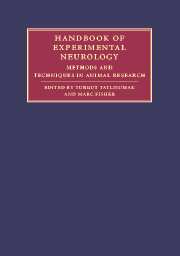Book contents
- Frontmatter
- Contents
- List of contributors
- Part I Principles and general methods
- 1 Introduction: Animal modeling – a precious tool for developing remedies to neurological diseases
- 2 Ethical issues, welfare laws, and regulations
- 3 Housing, feeding, and maintenance of rodents
- 4 Identification of individual animals
- 5 Analgesia, anesthesia, and postoperative care in laboratory animals
- 6 Euthanasia in small animals
- 7 Various surgical procedures in rodents
- 8 Genetically engineered animals
- 9 Imaging in experimental neurology
- 10 Safety in animal facilities
- 11 Behavioral testing in small-animal models: ischemic stroke
- 12 Methods for analyzing brain tissue
- 13 Targeting molecular constructs of cellular function and injury through in vitro and in vivo experimental models
- 14 Neuroimmunology and immune-related neuropathologies
- 15 Animal models of sex differences in non-reproductive brain functions
- 16 The ependymal route for central nervous system gene therapy
- 17 Neural transplantation
- Part II Experimental models of major neurological diseases
- Index
- References
8 - Genetically engineered animals
Published online by Cambridge University Press: 04 November 2009
- Frontmatter
- Contents
- List of contributors
- Part I Principles and general methods
- 1 Introduction: Animal modeling – a precious tool for developing remedies to neurological diseases
- 2 Ethical issues, welfare laws, and regulations
- 3 Housing, feeding, and maintenance of rodents
- 4 Identification of individual animals
- 5 Analgesia, anesthesia, and postoperative care in laboratory animals
- 6 Euthanasia in small animals
- 7 Various surgical procedures in rodents
- 8 Genetically engineered animals
- 9 Imaging in experimental neurology
- 10 Safety in animal facilities
- 11 Behavioral testing in small-animal models: ischemic stroke
- 12 Methods for analyzing brain tissue
- 13 Targeting molecular constructs of cellular function and injury through in vitro and in vivo experimental models
- 14 Neuroimmunology and immune-related neuropathologies
- 15 Animal models of sex differences in non-reproductive brain functions
- 16 The ependymal route for central nervous system gene therapy
- 17 Neural transplantation
- Part II Experimental models of major neurological diseases
- Index
- References
Summary
Introduction
Animal models that recreate specific pathogenic events and their corresponding behavioral outcomes are indispensable tools for exploring the underlying pathophysiologic mechanisms of disease and for investigating therapeutic strategies prior to testing them in human patients. Although rodents have a long tradition as models for human neurological diseases, they have received increasing attention in light of genetic engineering methods that have made it possible to create precisely defined genetic changes. The development of transgenic technology, a tool that allows sophisticated manipulation of the genome, has provided an unprecedented opportunity to expand our understanding of many aspects of neuronal development, function, and disease.
Transgenic animals are specific variants of species following the introduction and/or integration of a new gene or genes into the genome of the host animal. Transgenic technology is now routinely used to increase the level of (overexpress) particular proteins or enzymes in animals or to mutate or inactivate a particular gene using a “knockout” approach. One of the most commonly used animals in transgenic techniques is the mouse, a species in which transgene microinjections into the pronuclei of fertilized oocytes and the subsequent expression of the transgene in the animal have been carefully worked out.
Since their development in the 1980s, the transgenic and knockout technologies have allowed us to examine the regulation of gene expression and the pathophysiology of its alterations.
- Type
- Chapter
- Information
- Handbook of Experimental NeurologyMethods and Techniques in Animal Research, pp. 114 - 131Publisher: Cambridge University PressPrint publication year: 2006



